Solidarity Farms is one of the farms that have been proactive regarding soil health. Since purchasing the farm, the farm owners have focused on improving soil health. They have won a few grants geared towards improving soil health. They received the California Department of Food and Agriculture Healthy Soils Program (CDFA HSP) grant to spread compost and mulch. The program requires them to collect samples once a year to monitor soil organic matter; however, they went beyond the requirement to monitor other healthy soil parameters, including soil nutrients such as nitrogen. They applied for another grant from ZeroFoodPrint (ZFP) to continue implementing compost and mulch and adding other practices that they deemed essential. They won the award, and this document highlights some of their implemented healthy soils practices funded by the ZeroFoodPrint. The practices are estimated to reduce 108 metric tons CO2-equivalent when implemented as specified. Please refer to this link (www.comet-planner.com) to know how these estimates were generated.
Compost Application
Compost was applied to 10 acres at Solidarity Farms in the fourth quarter of 2020. They spread the compost using a compost spreader purchased through the ZeroFoodPrint funds (Figure 1). The compost (Figure 2) was purchased at San Pasqual Valley Soils, Escondido, CA.
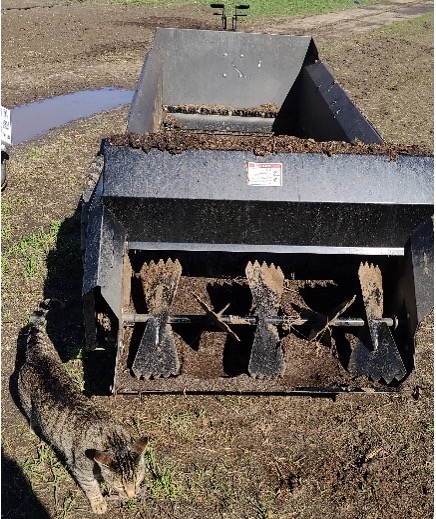
Compost application improved the soil workability as the soil structure was greatly improved, and the organic matter content was increased. Also, crops such as squash which were not previously able to grow on that land, were now able to survive through harvest. Compost application also helped support the growth of cover crops, which could not survive before applying compost. The above benefits show that the practice was critical in improving soil health.
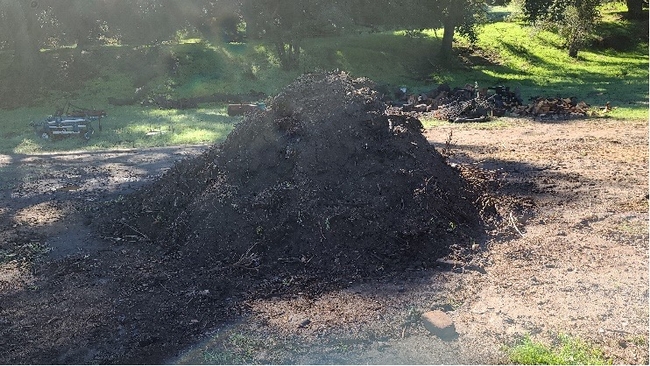
Cover Crop (CPS 340) - Add Non-Legume Seasonal Cover Crop to Irrigated Cropland
Solidarity Farms planted cover crops in a 10-acre portion of their farm to improve soil health, soil workability, and water infiltration. Cover cropping was very successful, and about 98% coverage of the soil by cover crops (Figure 3) was achieved. Cover crops were planted after composting to ensure a high rate of survival. A mixture of winter rye (25%), oat (24.5%), crimson clover (9.5%), peas (9.5%), and vetch (9.5%) was grown to improve soil nitrogen, reduce erosion and improve infiltration. The cover crop was planted during the rainy season to reduce the cost of irrigation. Termination of the cover crop was achieved by feeding it to the resident flock of chickens, which added manure into the soil, thus improving soil fertility. Also, as the chickens dug and scratched the ground, they mixed the topsoil, thus improving the soil workability and structure. The practice was crucial, and the growers were pleased with the improvements they saw in their farm.
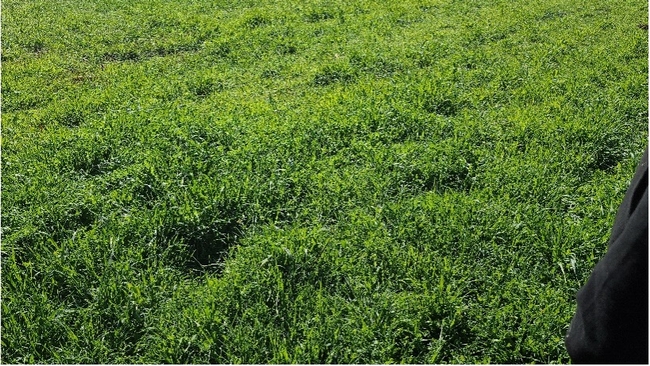
Hedgerow Planting (CPS 422) - Replace a Strip of Cropland with 1 Row of Woody Plants
Hedgerow Planting was another practice that was implemented at Solidarity Farms. The hedgerow species included many native plants. The hedgerow plants were grown in three rows (Figure 4). Hedgerow 1a was 155 ft long with 31 plants - including seven manzanita trees; Hedgerow 1b was 185 ft long, containing 34 plants - including eight elderberry trees. Hedgerow 1c was 154 ft long with 32 plants - including seven honey mesquite trees. The native plants did very well compared to non-native species. The establishment rate was about 96%, as very few plants died. The growers reduced the risk of plant mortality by planting the trees in mesh-wire baskets (Figure 4) to protect them from damage by gophers.
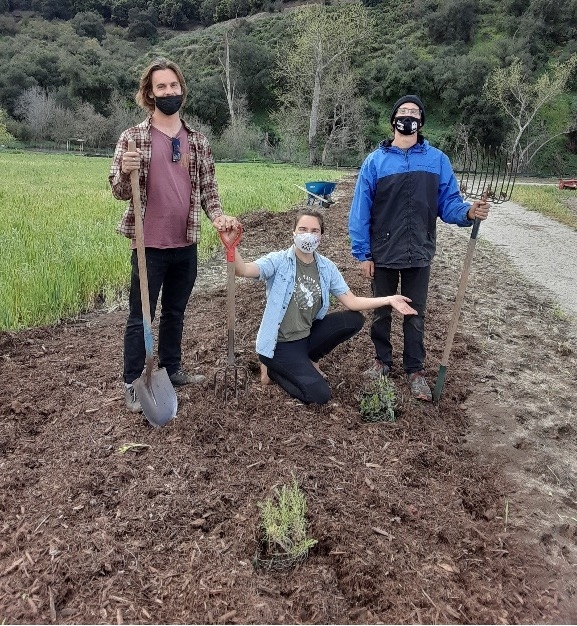
It was observed that the survival rate of plants that were planted without the wire mesh was lower as gophers cut their roots. The plants were watered weekly in summer to support their growth and utilized rainwater during the rainy season. After one year of planting, hedgerow plants are thriving (Figure 5), and the expectation is that they will continue to grow to become a suitable pollinator habitat. The plants will also act as a windbreak to protect the farm from harsh winds.
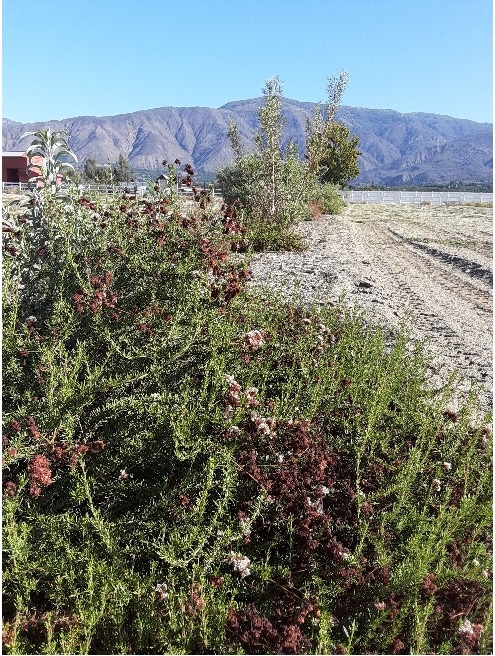
Residue and Tillage Management - No-Till (CPS 329) - Intensive Till to No-Till or Strip-Till on Irrigated Cropland
The Residue and Tillage Management – No-Till was implemented on a 40-acre parcel at Solidarity Farms. Cover crop mix was planted in the no-till area (Figure 6) to increase soil organic matter content, capture and recycle or redistribute nutrients in the soil profile, promote biological nitrogen fixation, suppress weeds, reduce soil compaction, and manage soil moisture. Cover crops were thriving as 98% cover of the soil was achieved. The cover crops will significantly help to restore the soil and increase the organic matter in the soil. Low disturbance from no-till means that soil biology would be more active than before. A variety of crops could be planted, and less fertilizer would be used to support plant growth.
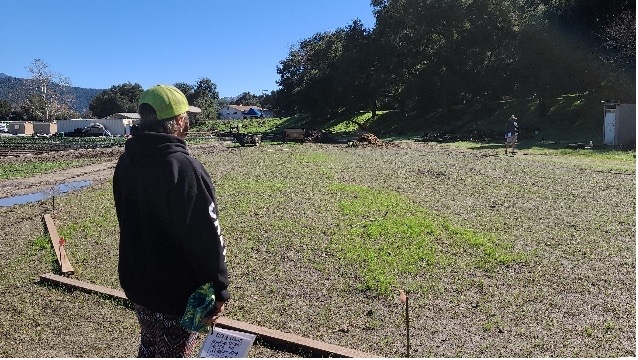
Tree/Shrub Establishment (CPS 612) – Conversion of Annual Cropland to a Farm Woodlot
Tree/shrub establishment was implemented in 1.25 acres distributed between the orchard and food forest. Implementing the practice was to transition to perennials and fruit production. The transition is advantageous as fruit trees would sequester carbon, and the soil will recover as it will no longer get disturbed by tillage. Of the 1.25 acres, ¾ acres was used for the orchard, which comprised tree species such as apples, peaches, stone fruit (plums), grapes, and pears. ½ acre was used for the food forest, including pecan trees, grapes, thornless blackberries, cherries, pomegranates, and stone fruit (Figure 7).
The selection of the tree species was based on cultural preferences, fruit trees varieties that do well in the local climate, and the soil type. The trees are irrigated using micro-emitters. During the rainy season, trees received limited irrigation depending on soil moisture availability. The survival rate of the trees was estimated to be 80%. Dwarf trees died due to heat stress in the first year, and they were replaced in the following year. A primary lesson learned in implementing the practice is that growers should use heavy mulch and compost when establishing trees and shrubs. Compost adds organic matter to the soil and helps to improve soil health, while mulch reduces water loss, suppresses weeds, and improves the overall soil nutrients.
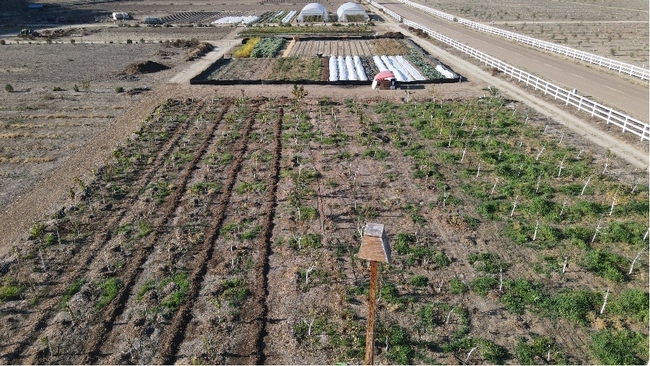
In conclusion, healthy soil practices improve some farms' soil, and benefits are evident. The owners are working hard to restore soil health to reap long-term benefits. Documenting these efforts and testimonies from these growers can encourage other growers to participate. The more growers participate in these activities, the more the impacts of climate change can be mitigated.